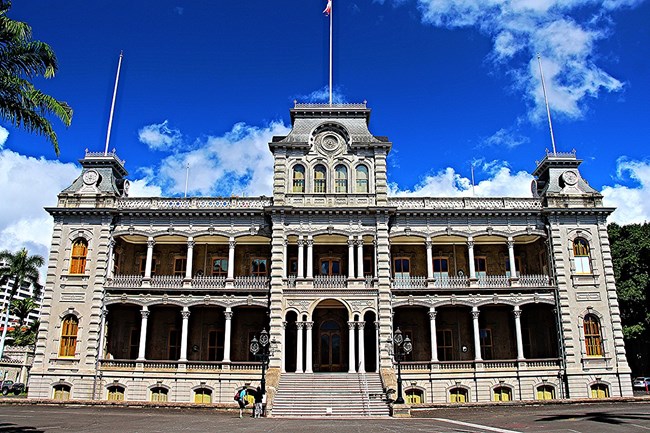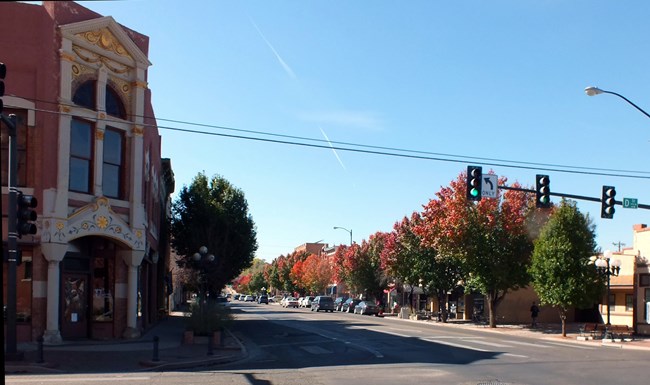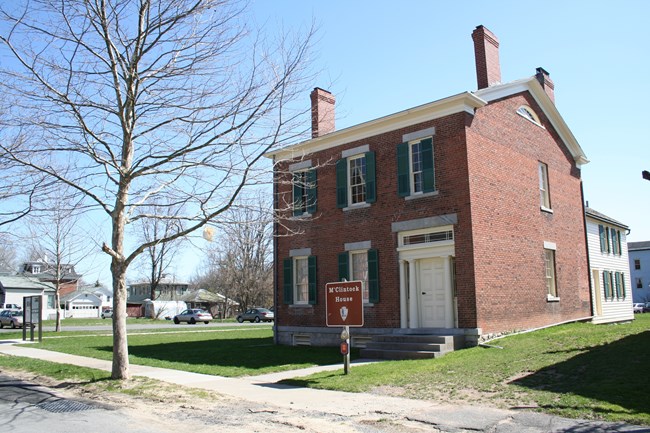Part of a series of articles titled Teaching with Historic Places Program and Where Did History Happen?: Selections from CRM, Vol 16, no 2 (1993).
Article
Teaching with Historic Places: Creating a Partnership

Photo by Jason Raia, CC BY 2.0, https://commons.wikimedia.org/w/index.php?curid=56835833
Selections from a Thematic Issue of CRM Vol 16 No. 2 1993
Published by the National Park Service, Cultural Resources
By: Carol D. Shull
Creating a Partnership
In 1991, the National Park Service and the National Trust for Historic Preservation formed a partnership to launch an ambitious program using properties listed in the National Register of Historic Places to educate our young people. As Chief of Registration for the National Register, I see the breadth of what we have to offer – the great variety of places that reflect our heritage, and the rich documentation about them. As a mother, I have seen my two children excited by a gifted teacher who brought history alive through creative, hands-on activities, only to watch their interest killed by one who only assigned chapters to read and facts to memorize. I marvel that it has taken us so long to find a way to make historic places, which so powerfully convey lessons about our past, widely available to teachers and students.
Why now? Because the time is right. We are in a period of major reform stemming from our concern over our children’s education. In the preservation world, it has become clear that we must put a higher priority on increasing support through education. We know that preservation improves the quality of life in communities, creates housing and jobs, promotes tourism and civic pride, and can instruct us about the history and contributions of all of our people. If we want Americans to truly care about preserving historic places, we must explain why they are important.
The growing interest in education has coincided with our own heightened awareness of the value of the National Register as a unique national inventory that should be made more accessible to the public. The National Register now lists over 60,000 buildings, sites, districts, structures and objects significant in American history, architecture, archeology, engineering and culture, including over 870,000 individual resources. Each registration file includes a description, statement of significance, bibliography, maps, photographs, and other useful data. Over half of the listings are part of “multiple property submissions” of properties related to a historic context, which might be as broad as the development of a community or focused on narrower themes in national, state, or local history. Often the National Register files and cultural resource survey reports are the only or best records of these places and their significance.

Photo by ERoss99, CC BY-SA 3.0, https://commons.wikimedia.org/w/index.php?curid=22381952
The National Register Information System (NRIS) makes it possible to identify places by location, functions, areas and periods of significance, important persons, architect/builder, cultural affiliation, and other ways. This computerized database not only has made the Register a more valuable planning tool, but has opened it for research on various aspects of American history by making it easier to find appropriate properties. For instance, the National Park Service and the National Conference of State Historic Preservation Officers are preparing a manuscript – to be published by the Trust’s Preservation Press – on over 700 registered properties associated with African American history, which were identified by querying the NRIS.
In 1988, Kathleen Hunter joined the National Trust to help develop a heritage education program that would build bridges to the education community. Kathleen asked me to participate in the Trust’s study. At meetings between educators and preservation advocates it became clear that educators are looking beyond textbooks to enrich the curriculum. Since then we have sought the advice of leading educators on how historic places and the information about them can be used to address major educational needs and issues.
I can honestly say that in my more than 20 years in preservation I have never participated in more enlightening and helpful discussions. Assembled preservation advocates, curriculum specialists, school administrators, classroom teachers, and national organization leaders were not shy in recommending ways to make it practical for teachers to use historic places in the classroom. Virtually all of the advice has helped shape the Teaching with Historic Places program.
The educators recommended against introducing new subjects into the already crowded curriculum. They emphasized that, without a mandate, teachers to not have time to teach historic preservation, architecture, or archeology. Educators also explained that reduced budgets have resulted in fewer field trips, but endorsed the educational value of historic places even if students cannot visit the sites. They suggested that we develop a program that would use historic places to teach history, social studies, and other required subjects in the core curriculum. Instructional materials, prepared with the input of experienced teachers in a standard lesson plan format, could clearly demonstrate how and where specific historic places can fit into the curriculum.

NPS photo.
Targeting middle schools while making materials flexible enough for upper elementary and high school levels was suggested, because those are the grades at which American history and topics such as geography and civics are taught. Preservationists and educators alike said that our instructional materials should show how comparable historic properties can be found in localities, making the connections between seemingly distant events and theoretical concepts and the students’ own communities and experiences. Ideally, a teacher could pick up a lesson plan the night before and use it the next day.
Elise Freeman, then Chief of the Education Branch, Office of Public Programs, at the National Archives and Records Administration, participated in our group because of the Teaching with Documents program that the Archives has run for over a decade in partnership with the National Council for the Social Studies (NCSS). Our advisors recommended that the Park Service and the Trust pattern products on the successful document-based learning packages and teacher training program developed by the National Archives, saving us from having to reinvent the when.
Nationally-known educator, Fay Metcalf, former Director of the National Commission for Social Studies in the Schools, wrote the first prototype lesson plans, and has become editor for the Teaching with Historic Places series. She has created a format teachers recognize as effective and developed guidelines for preparing lesson plans that can be used by preservationists and educators anywhere in the United States. We hope the series will include lessons written by authors throughout the country.
Fran Haley, Executive Director of NCSS, attested to the popularity of the Archives lessons, which are published as a regular feature in the NCSS journal, Social Education. She offered to publish the Teaching with Historic Places lessons as an ongoing series in Social Education, giving us another partner and enabling us to follow the advice that we make our materials available through channels school districts and teachers use.
If the Teaching with Historic Places program is to succeed, we must train teachers to use historic places and the documentation about them to create their own lesson plans. Preservation advocates, too, need to learn what educators need to use historic places in the curriculum. With this in mind, we have made training and the development of a curriculum framework that can help make the use of historic places a standard teaching skill elements of the Teaching with Historic Places program.
Support from several sources has made Teaching with Historic Places possible. Some of the National Park Service’s Parks as Classrooms funds – most of which are being used for programs in national parks – are helping to develop Teaching with Historic Places, because the program benefits parks, which contain nearly 20,000 resources listed in the National Register. Additional funds have come from special NPS training monies. The National Trust has provided the services of Kathleen Hunter and other staff, and costs of publishing and marketing our instructional materials. Our goal is to obtain the steady funding necessary to assure that Teaching with Historic Places can continue as an ongoing program.
I have not had space to mention everyone who has advised and assisted us, but I want to thank them all for their invaluable assistance in developing Teaching with Historic Places. The wisdom of their recommendations and the certainty that Teaching with Historic Places can and will make a major contribution have been affirmed by what I have read and observed.
We always have had the historic places that can tell the stories that need to be told. Now we have a program in which educators and preservation advocates everywhere can participate, and which assists our young people in developing the skills they must have to be productive citizens. I am convinced that the Teaching with Historic Places program is one of our most exciting opportunities.
At the time of publication, Carol D. Shull was the Chief of Registration, National Register of Historic Places, National Park Service.
Last updated: July 8, 2019
